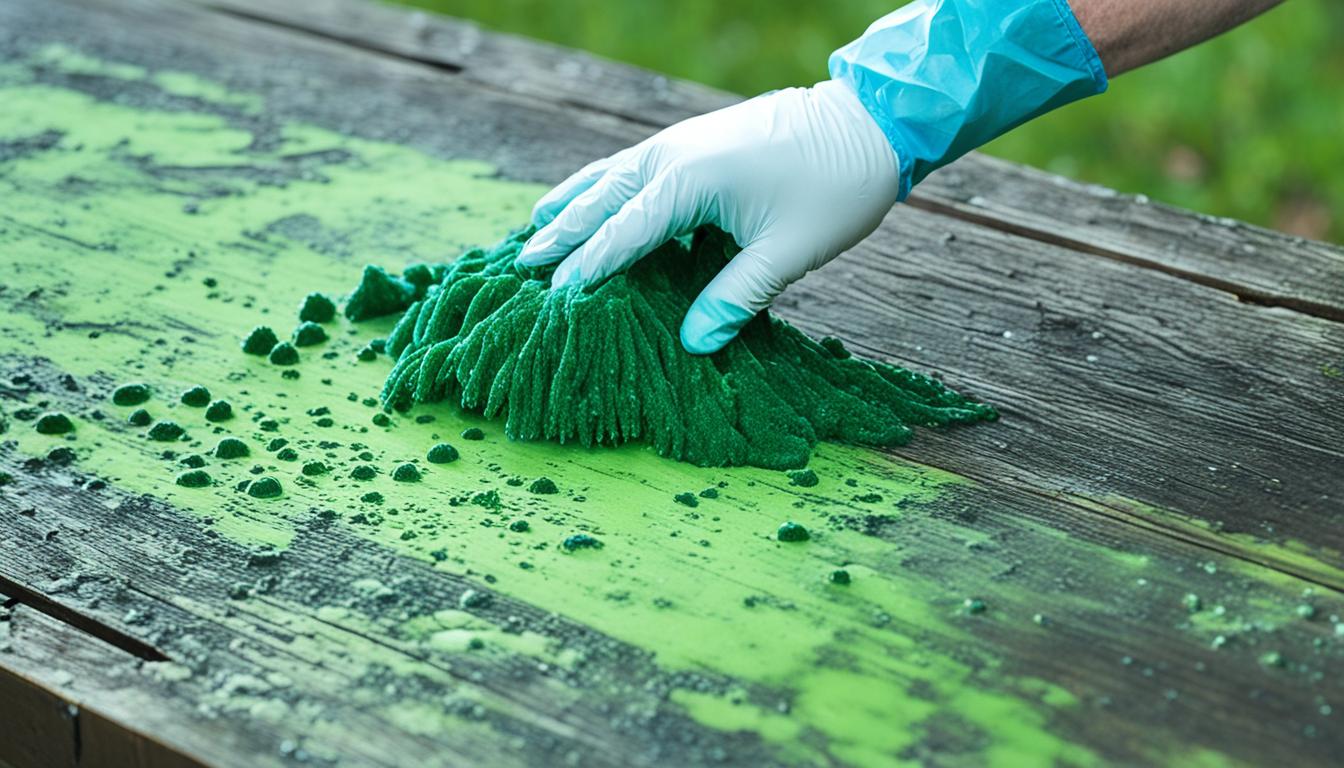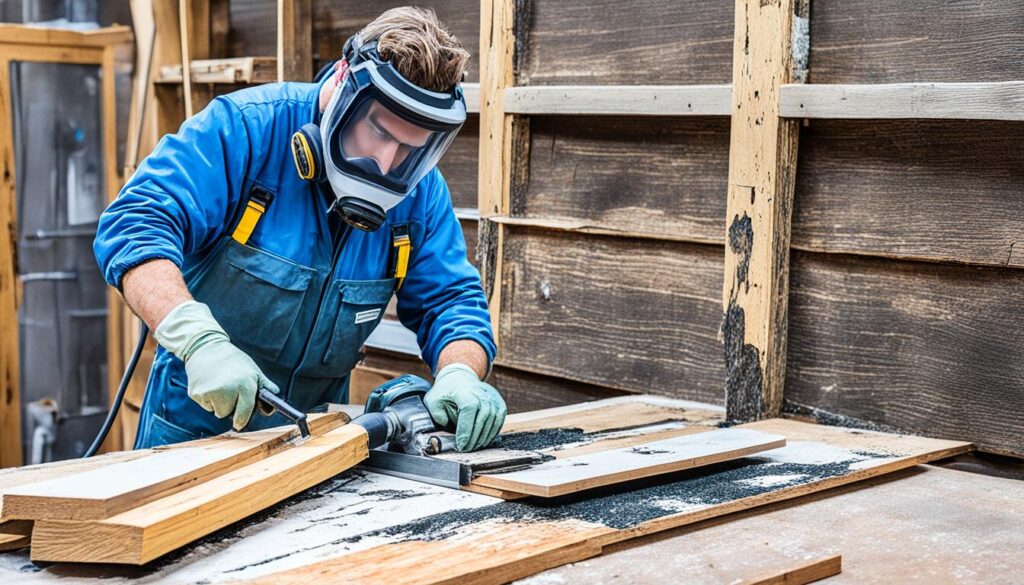
Remedies for Moldy Wood – Can You Fix Moldy Wood?
In this section, we will explore various remedies for moldy wood and determine if it is possible to fix moldy wood. Mold on wood surfaces can be a common problem, especially in areas with high humidity or moisture. It not only affects the appearance of your wooden surfaces but can also compromise their structural integrity.
Repairing moldy wood involves a combination of strategies, including wood mold removal, treating mold on wood, and fixing mold damage. By addressing the issue promptly and taking appropriate measures, you can restore your wood to its former glory and prevent further damage.
Key Takeaways:
- Repairing moldy wood is possible with the right strategies and techniques.
- Wood mold removal and treating mold on wood are essential steps in the remediation process.
- Fixing mold damage and wood rot repair can restore the strength and durability of moldy wood.
- Prompt action is crucial to prevent further damage and protect the longevity of wooden surfaces.
- If you need professional assistance, contact Fix Mold Miami at 305-465-6653 for a mold assessment.
Effective Strategies for Treating Mold on Wood
When it comes to treating mold on wood, it’s crucial to take immediate action to prevent further damage and protect your wooden surfaces. In this section, we will explore different effective strategies for removing mold from wood and discuss the importance of mold remediation for wood.
1. Identify and Remove the Source:
The first step in treating mold on wood is to identify and eliminate the source of moisture that is causing the mold growth. Inspect the area thoroughly and address any water leaks or excessive humidity levels. By addressing the source, you can prevent mold from recurring.
“Effective mold treatment starts with identifying and removing the source of moisture. Only then can we successfully eradicate mold from wood surfaces.”
2. Clean the Moldy Wood:
Once the source of moisture is addressed, it’s time to clean the moldy wood. Wear protective gear, including gloves and a mask, to prevent exposure to mold spores. Use a stiff brush or a sponge soaked in a mixture of water and mild detergent to scrub the affected area. Rinse the wood surface thoroughly and allow it to dry completely.
3. Apply an Anti-Microbial Solution:
After cleaning the moldy wood, apply an anti-microbial solution to inhibit the growth of mold spores and prevent future mold infestation. Choose a product specifically designed for mold remediation on wood surfaces and follow the manufacturer’s instructions carefully.
4. Sand and Seal the Wood:
If the mold has penetrated the wood surface deeply, sanding may be necessary to remove any remaining traces. Use fine-grit sandpaper to gently sand the affected area and ensure a smooth, even surface. After sanding, seal the wood with a primer or a wood sealer to prevent moisture absorption and inhibit mold growth.
5. Monitor and Maintain:
Regular monitoring is essential to prevent mold recurrence on treated wood surfaces. Keep an eye out for any signs of moisture or mold growth and address them promptly. Additionally, maintain proper ventilation and humidity levels to create an unfavorable environment for mold to thrive.
By following these effective strategies for treating mold on wood, you can successfully remove mold from wood surfaces and protect your wooden structures from further damage. Remember, if the mold infestation is extensive or persistent, it is recommended to seek professional mold remediation services.

Quote:
“Effective mold treatment starts with identifying and removing the source of moisture. Only then can we successfully eradicate mold from wood surfaces.”
Restoring Strength: Fixing Mold Damage and Wood Rot Repair
In this section, we will focus on restoring the strength of mold-damaged wood and repairing wood rot. Mold damage and wood rot are common issues that can compromise the structural integrity of wooden surfaces. However, with the right techniques, it is possible to repair moldy wood and prolong its lifespan.
Step-by-Step Guide to Repairing Moldy Wood
To repair moldy wood, follow these step-by-step instructions:
- Identify and isolate the affected areas: Inspect the wood for visible signs of mold, such as discoloration, musty odor, or soft spots. Once identified, isolate the area to prevent further contamination.
- Prepare the work area: Put on protective gear, including gloves, goggles, and a mask. Open windows or use ventilation to improve air circulation.
- Remove mold from the surface: Using a stiff brush, scrub the moldy surface to remove loose mold particles. Ensure thorough cleaning and dispose of any debris in a sealed bag.
- Treat the wood with a mold remover: Apply a commercial mold remover or a mixture of bleach and water to the affected area. Follow the product instructions and let it sit for the recommended duration.
- Scrub the surface again: After the treatment, scrub the surface once more to remove any remaining mold and residue.
- Dry the wood: Allow the wood to dry completely. Use fans or dehumidifiers to expedite the process and prevent moisture from lingering.
- Apply a wood preservative: Once the wood is dry, apply a wood preservative to protect against future mold growth and wood rot.
- Repair or replace damaged sections: If the wood has suffered structural damage or rot, assess the extent and consider repairing or replacing the affected sections.
- Seal and finish the wood: Finally, seal and finish the wood with an appropriate sealant or paint to enhance its durability and appearance.
Following these repair steps will help you effectively fix mold damage and restore the strength of the affected wood.
Strengthening Weakened Areas and Preventing Future Damage
In addition to repairing moldy wood, it is crucial to strengthen weakened areas to prevent future damage. Here are some methods you can use:
- Reinforce with epoxy: Epoxy can be used to strengthen weakened wood by filling in gaps and reinforcing the structure.
- Apply wood hardener: Wood hardener penetrates the wood fibers and helps restore strength to weakened areas.
- Replace damaged sections: If a section of the wood is severely damaged or rotted, it may be necessary to replace it entirely to ensure structural integrity.
- Maintain proper ventilation: Proper ventilation is essential in preventing mold growth and wood rot. Ensure sufficient airflow in areas prone to moisture and humidity.
- Address moisture sources: Identify and address any moisture sources that contribute to mold growth and wood rot. Fix leaks, repair plumbing issues, and improve drainage to prevent further damage.
By following these techniques, you can strengthen weakened areas and protect your wood from future mold damage and wood rot.

Conclusion
In conclusion, dealing with moldy wood can be a daunting task, but it is not insurmountable. By implementing effective strategies for mold treatment, removal, and damage repair, you can successfully restore your moldy wood and prevent future issues. Take prompt action to address moldy wood and safeguard the longevity of your wooden surfaces.
If you find yourself needing professional assistance with mold assessment and remediation, consider reaching out to Fix Mold Miami at 305-465-6653. With their expertise, you can ensure thorough evaluation and expert guidance throughout the process.
Remember, prevention is key. Regularly inspect your wooden surfaces, maintain proper ventilation, and address any moisture issues promptly. By staying vigilant and taking proactive measures, you can protect your wood from mold and preserve its beauty and structural integrity for years to come.




